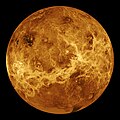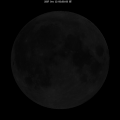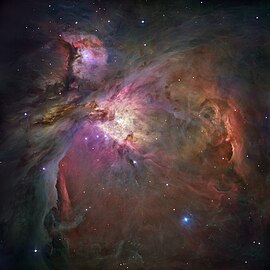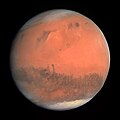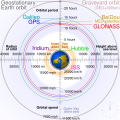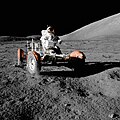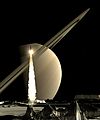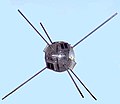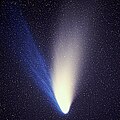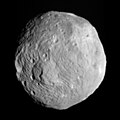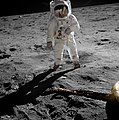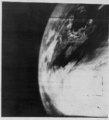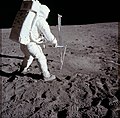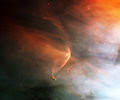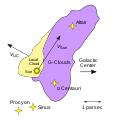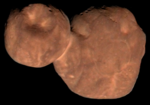Portal:Outer space
Portal maintenance status: (April 2019)
|
Introduction

Outer space (or simply space) is the expanse that exists beyond Earth's atmosphere and between celestial bodies. It contains ultra-low levels of particle densities, constituting a near-perfect vacuum of predominantly hydrogen and helium plasma, permeated by electromagnetic radiation, cosmic rays, neutrinos, magnetic fields and dust. The baseline temperature of outer space, as set by the background radiation from the Big Bang, is 2.7 kelvins (−270 °C; −455 °F).
The plasma between galaxies is thought to account for about half of the baryonic (ordinary) matter in the universe, having a number density of less than one hydrogen atom per cubic metre and a kinetic temperature of millions of kelvins. Local concentrations of matter have condensed into stars and galaxies. Intergalactic space takes up most of the volume of the universe, but even galaxies and star systems consist almost entirely of empty space. Most of the remaining mass-energy in the observable universe is made up of an unknown form, dubbed dark matter and dark energy.
Outer space does not begin at a definite altitude above Earth's surface. The Kármán line, an altitude of 100 km (62 mi) above sea level, is conventionally used as the start of outer space in space treaties and for aerospace records keeping. Certain portions of the upper stratosphere and the mesosphere are sometimes referred to as "near space". The framework for international space law was established by the Outer Space Treaty, which entered into force on 10 October 1967. This treaty precludes any claims of national sovereignty and permits all states to freely explore outer space. Despite the drafting of UN resolutions for the peaceful uses of outer space, anti-satellite weapons have been tested in Earth orbit.
The concept that the space between the Earth and the Moon must be a vacuum was first proposed in the 17th century after scientists discovered that air pressure decreased with altitude. The immense scale of outer space was grasped in the 20th century when the distance to the Andromeda Galaxy was first measured. Humans began the physical exploration of space later in the same century with the advent of high-altitude balloon flights. This was followed by crewed rocket flights and, then, crewed Earth orbit, first achieved by Yuri Gagarin of the Soviet Union in 1961. The economic cost of putting objects, including humans, into space is very high, limiting human spaceflight to low Earth orbit and the Moon. On the other hand, uncrewed spacecraft have reached all of the known planets in the Solar System. Outer space represents a challenging environment for human exploration because of the hazards of vacuum and radiation. Microgravity has a negative effect on human physiology that causes both muscle atrophy and bone loss. (Full article...)
Selected article
243 Ida is an asteroid in the Koronis family of the main belt. It was discovered on 29 September 1884 by Johann Palisa and named after a nymph from Greek mythology. Later telescopic observations categorized Ida as an S-type asteroid, the most numerous type in the inner asteroid belt. On 28 August 1993, Ida was visited by the spacecraft Galileo, bound for Jupiter. It was the second asteroid to be visited by a spacecraft and the first found to possess a satellite. Like all main-belt asteroids, Ida's orbit lies between the planets Mars and Jupiter. Its orbital period is 4.84 years, and its rotation period is 4.63 hours. Ida has an average diameter of 31.4 km (19.5 mi). It is irregularly shaped and elongated, and apparently composed of two large objects connected together in a shape reminiscent of a croissant. Its surface is one of the most heavily cratered in the Solar System, featuring a wide variety of crater sizes and ages. Ida's moon, Dactyl, was discovered by mission member Ann Harch in images returned from Galileo. It was named after creatures which inhabited Mount Ida in Greek mythology. Data returned from the flyby pointed to S-type asteroids as the source for the ordinary chondrite meteorites, the most common type found on the Earth's surface.
Selected picture
-
Image 1Photo credit: Spitzer Space TelescopeThis infrared image shows hundreds of thousands of stars crowded into the swirling core of our spiral Milky Way galaxy. In visible-light pictures, this region cannot be seen at all because cosmic dust lying between Earth and the galactic center blocks our view.
-
Image 2NGC 6357 is a diffuse nebula in the constellation Scorpius. This composite image of the nebula contains X-ray data from the Chandra X-ray Observatory and the ROSAT telescope (purple), infrared data from the Spitzer Space Telescope (orange), and optical data from the SuperCosmos Sky Survey (blue). Radiation from hot, young stars is energizing the cooler gas in the clouds that surround them. Often known as the Lobster Nebula, the astronomical object has also been termed the Madokami Nebula by fans of the anime Madoka Magica due to its supposed resemblance to the main character. Scientists at the Midcourse Space Experiment prefer the name War and Peace Nebula, because the bright, western part resembles a dove, while the eastern part looks like a skull in infrared images.
-
Image 3

Color-composite image of the Pleiades from the Digitized Sky Survey Credit: NASA, ESA, AURA/Caltech, Palomar ObservatoryThe Pleiades (also known as M45 or the Seven Sisters) is an open cluster in the constellation of Taurus. It is among the nearest to the Earth of all open clusters, probably the best known and certainly the most striking to the naked eye. -
Image 4Photo: Yuri Beletsky, ESOA laser shoots towards the centre of the Milky Way from the Very Large Telescope facility in Chile, to provide a laser guide star, a reference point in the sky for the telescope's adaptive optics (AO) system. AO technology improves the performance of optical systems by reducing the effect of atmospheric distortion. AO was first envisioned by Horace W. Babcock in 1953, but did not come into common usage until advances in computer technology during the 1990s made the technique practical.
-
Image 5Photo: NASA/Crew of Expedition 22Space Shuttle Endeavour in a photograph taken from the International Space Station, in which the shuttle appears to straddle the stratosphere and mesosphere. During this mission, STS-130, the shuttle's primary payloads were the Tranquility module and the Cupola, a robotic control station which provides a 360-degree view around the station.
-
Image 6
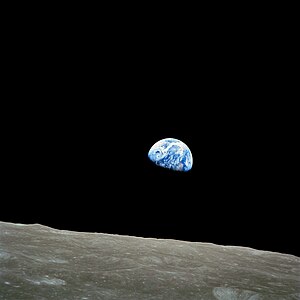
Earthrise, as seen by Apollo 8 Credit: William Anders"Earthrise," the first occasion in which humans saw the Earth seemingly rising above the surface of the Moon, taken during the Apollo 8 mission on December 24, 1968. This view was seen by the crew at the beginning of its fourth orbit around the Moon, although the very first photograph taken was in black-and-white. Note that the Earth is in shadow here. A photo of a fully lit Earth would not be taken until the Apollo 17 mission. -
Image 7Photograph: NASA, ESA, A. Aloisi (STScI/ESA), and The Hubble Heritage (STScI/AURA)-ESA/Hubble CollaborationAn image of NGC 4449, highlighting its qualities as a starburst galaxy. NGC 4449, an irregular galaxy in the constellation Canes Venatici located about 12 million light years from Earth, has a rate of star formation twice that of the Milky Way's satellite galaxy, the Large Magellanic Cloud. Interactions with nearby galaxies are thought to have influenced this star formation.
-
Image 8Photograph: Ken CrawfordNGC 4565 (also known as the Needle Galaxy) is an edge-on spiral galaxy about 30 to 50 million light-years away in the constellation Coma Berenices. NGC 4565 is a giant spiral galaxy more luminous than the Andromeda Galaxy, and has a population of roughly 240 globular clusters, more than the Milky Way.
-
Image 9Image credit: NASAA radar image of the surface of Venus, centered at 180 degrees east longitude. This composite image was created from mapping by the Magellan probe, supplemented by data gathered by the Pioneer orbiter, with simulated hues based on color images recorded by Venera 13 and 14. No probe has been able to survive more than a few hours on Venus's surface, which is completely obscured by clouds, because the atmospheric pressure is some 90 times that of the Earth's, and its surface temperature is around 450 °C (842 °F).
-
Image 10Image: Tom RuenAn animation of the phases of the Moon. As the Moon revolves around the Earth, the Sun lights the Moon from a different side, creating the different phases. In the image, the Moon appears to get bigger as well as "wobble" slightly. Tidal locking synchronizes the Moon's rotation period on its axis to match its orbital period around the earth. These two periods nearly cancel each other out, except that the Moon's orbit is elliptical. This causes its orbital motion to speed up when closer to the Earth, and slow down when farther away, causing the Moon's apparent diameter to change, as well as the wobbling motion observed.
-
Image 11A composite photo of the Orion Nebula, the closest region of star formation to Earth. It is composed of 520 separate images and NASA calls it "one of the most detailed astronomical images ever produced". The nebula is located below Orion's Belt and is visible to the naked eye at night. It is one of the most scrutinized and photographed objects in the night sky, and is among the most intensely-studied celestial features.
-
Image 12Photograph credit: European Space AgencyMars is the fourth planet from the Sun and is known as the "Red Planet" due to its reddish appearance as seen from Earth. The planet is named after Mars, the Roman god of war. A terrestrial planet, Mars has a thin atmosphere and surface features reminiscent both of the impact craters of the Moon and the volcanoes, valleys, deserts and polar ice caps of the Earth. The planet has the highest mountain in the Solar System, Olympus Mons, as well as the largest canyon, Valles Marineris. Mars's rotation period and seasonal cycles are also similar to those of the Earth. Of all the planets in the Solar System other than Earth, Mars is the most likely to harbour liquid water and perhaps life. There are ongoing investigations assessing Mars's past potential for habitability, as well as the possibility of extant life. Future astrobiology missions are planned, including NASA's Mars 2020 rover and the European Space Agency (ESA)'s Rosalind Franklin rover. In November 2016, NASA reported finding a large amount of underground ice in the Utopia Planitia region of the planet. The volume of water detected has been estimated to be equivalent to the volume of water in Lake Superior. Mars has two moons, Phobos and Deimos, which are small and irregularly shaped.
This picture is a true-colour image of Mars, taken from a distance of about 240,000 kilometres (150,000 mi) by the OSIRIS instrument on ESA's Rosetta spacecraft, during its February 2007 flyby of the planet. The image was generated using OSIRIS's orange (red), green and blue filters. -
Image 13"The Blue Marble" is a famous photograph of Earth. NASA officially credits the image to the entire Apollo 17 crew — Eugene Cernan, Ronald Evans and Jack Schmitt — all of whom took photographic images during the mission. Apollo 17 passed over Africa during daylight hours and Antarctica is also illuminated. The photograph was taken approximately five hours after the spacecraft's launch, while en route to the Moon. Apollo 17, notably, was the last manned lunar mission; no humans since have been at a range where taking a "whole-Earth" photograph such as "The Blue Marble" would be possible.
-
Image 14Animation credit: CmgleeThis is an animation showing geocentric satellite orbits, to scale with the Earth, at 3,600 times actual speed. The second-outermost (shown in grey) is a geostationary orbit, 35,786 kilometres (22,236 miles) above Earth's equator and following the direction of Earth's rotation, with an orbital period matching the planet's rotation period (a geosynchronous orbit). An object in such an orbit will appear to occupy a fixed position in the sky. Some 300 kilometres (190 miles) farther away is the graveyard orbit (brown), used for satellites at the end of their operational lives. Nearer to the Earth are the orbits of navigational satellites, such as Galileo (turquoise), BeiDou (beige), GPS (blue) and GLONASS (red), in medium Earth orbits. Much closer to the planet, and within the inner Van Allen belt, are satellites in low Earth orbit, such as the Iridium satellite constellation (purple), the Hubble Space Telescope (green) and the International Space Station (magenta).
-
Image 15The asteroid 433 Eros was named after the Greek god of love Eros. This S-type asteroid is the second-largest near-Earth asteroid. This image shows the view looking from one end of the asteroid across the gouge on its underside and toward the opposite end.
-
Image 16Photo credit: Mars Reconnaissance OrbiterFalse-color Mars Reconnaissance Orbiter image of a side of the Chasma Boreale, a canyon in the polar ice cap of the Planum Boreum (north pole of Mars). Light browns are layers of surface dust, greys and blues are layers of water and carbon dioxide ice. Regular geometric cracking is indicative of higher concentrations of water ice.
The Planum Boreum's permanent ice cap has a maximum depth of 3 km (1.9 mi). It is roughly 1200 km (750 mi) in diameter, an area equivalent to about 1½ times the size of Texas. The Chasma Boreale is up to 100 km (62.5 mi) wide and features scarps up to 2 km (1.25 mi) high. For a comparison, the Grand Canyon is approximately 1.6 km (1 mi) deep in some places and 446 km (279 mi) long but only up to 24 km (15 mi) wide. -
Image 17Image credit: United States Geological SurveyA composite image of Olympus Mons on Mars, the tallest known volcano and mountain in the Solar System. This image was created from black-and-white imagery from the USGS's Mars Global Digital Image Mosaic and color imagery acquired from the 1978 visit of Viking 1.
-
Image 18NASA astronaut Robert Curbeam (left) and European Space Agency (ESA) astronaut Christer Fuglesang participate in STS-116's first of three planned sessions of extra-vehicular activity (EVA) as construction resumes on the International Space Station. The landmasses depicted in the background are the South Island (left) and North Island (right) of New Zealand.
-
Image 19Photo credit: Harrison SchmittAstronaut Eugene Cernan makes a short test drive of the lunar rover (officially, Lunar Roving Vehicle or LRV) during the early part of the first Apollo 17 extravehicular activity. The LRV was only used in the last three Apollo missions, but it performed without any major problems and allowed the astronauts to cover far more ground than in previous missions. All three LRVs were abandoned on the Moon.
-
Image 20Image credit: Dave JarvisAn illustration of relative astronomical orders of magnitude, starting with the terrestrial planets of the Solar System in image 1 (top left) and ending with the largest known star, VY Canis Majoris, at the bottom right. The biggest celestial body in each image is shown on the left of the next frame.
-
Image 21The Pioneer plaque, which was included on both Pioneer 10 and Pioneer 11 unmanned spacecraft, the first man-made objects to leave the Solar System. Made from gold-anodised aluminium, the plaque shows the figures of a man and a woman along with several symbols that are designed to provide information about the origin of the spacecraft. However, the mean time for the spacecraft to come within 30 astronomical units of a star is longer than the current age of our galaxy.
-
Image 22
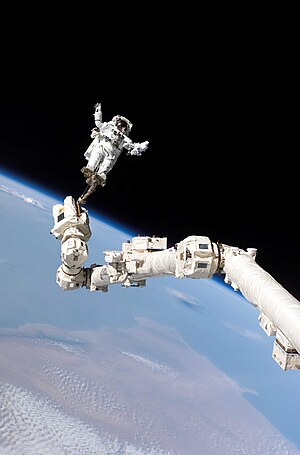
Astronaut Steve Robinson on a spacewalk, August 2005 Credit: NASAExtra-vehicular activity (EVA) is work done by an astronaut away from the Earth and outside of his or her spacecraft. EVAs may be made outside a craft orbiting Earth (a spacewalk) or on the surface of the Moon (a moonwalk). Shown here is Steve Robinson on the first EVA to perform an in-flight repair of the Space Shuttle (August 3 2005).
Space-related portals
General images
-
Image 2A computer-generated animation by the European Space Agency representing space debris in low earth orbit at the current rate of growth compared to mitigation measures being taken (from Space debris)
-
Image 3Atmospheric attenuation in dB/km as a function of frequency over the EHF band. Peaks in absorption at specific frequencies are a problem, due to atmosphere constituents such as water vapor (H2O) and carbon dioxide (CO2). (from Interstellar medium)
-
Image 4Artistic image of a rocket lifting from a Saturn moon (from Space exploration)
-
Image 5Reconstruction of solar activity over 11,400 years. Period of equally high activity over 8,000 years ago marked. (from Space climate)
-
Image 6Earth and the Moon as seen from cislunar space on the 2022 Artemis 1 mission (from Outer space)
-
Image 7A MESSENGER image from 18,000 km showing a region about 500 km across (2008) (from Space exploration)
-
Image 8Debris impacts on Mir's solar panels degraded their performance. The damage is most noticeable on the panel on the right, which is facing the camera with a high degree of contrast. Extensive damage to the smaller panel below is due to impact with a Progress spacecraft. (from Space debris)
-
Image 9A micrometeoroid left this crater on the surface of Space Shuttle Challenger's front window on STS-7. (from Space debris)
-
Image 10Vanguard 1 is expected to remain in orbit for 240 years. (from Space debris)
-
Image 11Major elements of 200 stratospheric interplanetary dust particles. (from Cosmic dust)
-
Image 12The original Magdeburg hemispheres (left) used to demonstrate Otto von Guericke's vacuum pump (right)
-
Image 14Conventional anti-satellite weapons such as the SM-3 missile remain legal under the law of armed conflict, even though they create hazardous space debris (from Outer space)
-
Image 17Near-Earth space showing the low-Earth (blue), medium Earth (green), and high Earth (red) orbits. The last extends beyond the radius of geosynchronous orbits (from Outer space)
-
Image 18Space debris identified as WT1190F, burning up in a fireball over Sri Lanka (from Space debris)
-
Image 19Spent upper stage of a Delta II rocket, photographed by the XSS 10 satellite (from Space debris)
-
Image 20View of an orbital debris hole made in the panel of the Solar Max satellite (from Space debris)
-
Image 21Cosmic dust of the Horsehead Nebula as revealed by the Hubble Space Telescope. (from Cosmic dust)
-
Image 22The sparse plasma (blue) and dust (white) in the tail of comet Hale–Bopp are being shaped by pressure from solar radiation and the solar wind, respectively.
-
Image 23For the first time, the NASA / ESA / Canadian Space Agency / James Webb Space Telescope has observed the chemical signature of carbon-rich dust grains at redshift z ≈ 7, which is roughly equivalent to one billion years after the birth of the Universe, this observation suggests exciting avenues of investigation into both the production of cosmic dust and the earliest stellar populations in our Universe. (from Cosmic dust)
-
Image 25Voyager 1 is the first artificial object to reach the interstellar medium. (from Interstellar medium)
-
Image 26The distribution of ionized hydrogen (known by astronomers as H II from old spectroscopic terminology) in the parts of the Galactic interstellar medium visible from the Earth's northern hemisphere as observed with the Wisconsin Hα Mapper (Haffner et al. 2003) harv error: no target: CITEREFHaffnerReynoldsTufteMadsen2003 (help). (from Interstellar medium)
-
Image 27A laser-guided observation of the Milky Way Galaxy at the Paranal Observatory in Chile in 2010 (from Outline of space science)
-
Image 28Apollo Command Service Module in lunar orbit (from Space exploration)
-
Image 30Astronaut Buzz Aldrin had a personal Communion service when he first arrived on the surface of the Moon. (from Space exploration)
-
Image 31First television image of Earth from space, taken by TIROS-1 (1960) (from Space exploration)
-
Image 32Space Shuttle Endeavour had a major impact on its radiator during STS-118. The entry hole is about 5.5 mm (0.22 in), and the exit hole is twice as large. (from Space debris)
-
Image 34Perseverance's backshell sitting upright on the surface of Jezero Crater (from Space debris)
-
Image 35Concept art for a NASA Vision mission (from Space exploration)
-
Image 36NASA computer-generated image of debris objects in Earth orbit, c. 2005 (from Space debris)
-
Image 37The Long Duration Exposure Facility (LDEF) is an important source of information on small-particle space debris. (from Space debris)
-
Image 38Debris density in low Earth orbit (from Space debris)
-
Image 39Astronomers used the James Webb Space Telescope to image the warm dust around a nearby young star, Fomalhaut, in order to study the first asteroid belt ever seen outside of the Solar System in infrared light. (from Cosmic dust)
-
Image 41Growth of tracked objects in orbit and related events; efforts to manage outer space global commons have so far not reduced the debris or the growth of objects in orbit (from Space debris)
-
Image 42Gabbard diagram of almost 300 pieces of debris from the disintegration of the five-month-old third stage of the Chinese Long March 4 booster on 11 March 2000 (from Space debris)
-
Image 43The diversity found in the different types and scales of astronomical objects make the field of study increasingly specialized. (from Outline of space science)
-
Image 46Timeline of the expansion of the universe, where visible space is represented by the circular sections. At left, a dramatic expansion occurs in the inflationary epoch, and at the center, the expansion accelerates. Neither time nor size are to scale. (from Outer space)
-
Image 48Objects in Earth orbit including fragmentation debris, November 2020, NASA: ODPO (from Space debris)
-
Image 49The International Space Station is an orbiting laboratory for space applications and habitability. Visible in the background is yellow-green airglow of Earth's ionosphere and the interstellar field of the Milky Way. (from Outer space)
-
Image 50Illustration of Earth's atmosphere gradual transition into outer space (from Outer space)
-
Image 51A computer-generated map of objects orbiting Earth, as of 2005. About 95% are debris, not working artificial satellites (from Outer space)
-
Image 53Astronaut Piers Sellers during the third spacewalk of STS-121, a demonstration of orbiter heat shield repair techniques (from Outline of space science)
-
Image 54Model of Vostok spacecraft (from Space exploration)
-
Image 55After reentry, Delta 2 second stage pieces were found in South Africa. (from Space debris)
-
Image 57A dusty trail from the early Solar System to carbonaceous dust today. (from Cosmic dust)
-
Image 59Known orbit planes of Fengyun-1C debris one month after the weather satellite's disintegration by the Chinese ASAT (from Space debris)
-
Image 60This light-year-long knot of interstellar gas and dust resembles a caterpillar. (from Interstellar medium)
-
Image 62Large-scale matter distribution in a cubic section of the universe. The blue fiber-like structures represent the matter, and the empty regions in between represent the cosmic voids of the intergalactic medium (from Outer space)
-
Image 63Smooth chondrite interplanetary dust particle. (from Cosmic dust)
-
Image 64South is up in the first image of Earth taken by a person, probably by Bill Anders (during the 1968 Apollo 8 mission) (from Outer space)
-
Image 66Buzz Aldrin taking a core sample of the Moon during the Apollo 11 mission (from Space exploration)
-
Image 67Artist's impression of dust formation around a supernova explosion. (from Cosmic dust)
-
Image 68Infographic showing the space debris situation in different kinds of orbits around Earth (from Space debris)
-
Image 69Because of the hazards of a vacuum, astronauts must wear a pressurized space suit while outside their spacecraft.
-
Image 70Spatial density of LEO space debris by altitude, according to 2011 a NASA report to the United Nations Office for Outer Space Affairs (from Space debris)
-
Image 71Spatial density of space debris by altitude according to ESA MASTER-2001, without debris from the Chinese ASAT and 2009 collision events (from Space debris)
-
Image 72Illustration of a satellite breaking up into multiple pieces at higher altitudes (from Space debris)
-
Image 73Bow shock formed by the magnetosphere of the young star LL Orionis (center) as it collides with the Orion Nebula flow
-
Image 75Apollo 16 LEM Orion, the Lunar Roving Vehicle and astronaut John Young (1972) (from Space exploration)
-
Image 76Map showing the Sun located near the edge of the Local Interstellar Cloud and Alpha Centauri about 4 light-years away in the neighboring G-Cloud complex (from Interstellar medium)
-
Image 77A wide field view of outer space as seen from Earth's surface at night. The interplanetary dust cloud is visible as the horizontal band of zodiacal light, including the false dawn (edges) and gegenschein (center), which is visually crossed by the Milky Way (from Outer space)
-
Image 78A proposed timeline of the origin of space, from physical cosmology (from Outline of space science)
-
Image 79Cosmic dust of the Andromeda Galaxy as revealed in infrared light by the Spitzer Space Telescope. (from Cosmic dust)
Did you know (auto-generated)

- ... that, for the Space 220 Restaurant, Disney reached out to NASA engineers to understand what a space elevator might look like?
- ... that some severe environmental impacts of the invasion of Ukraine can be seen from space?
- ... that the space industry of India has supported the launch of more than 100 domestic satellites and more than 300 foreign satellites?
- ... that Nature's Fynd, producer of microbe-based meat substitutes, is working with NASA to develop a bioreactor for use in space travel?
- ... that Louis W. Roberts was among the highest ranking African-American space program staff at NASA while the Apollo program was underway?
Space news
{{2025 in space}}
Upcoming spaceflight launches
For a full schedule of launches and deep-space rendezvous, see 2025 in spaceflight.
|
Astronomical events
Topics
| Biology |
| |||||
|---|---|---|---|---|---|---|
| Environment | ||||||
| Society | ||||||
| Technology |
| |||||
2020 in space | ||
|---|---|---|
| Space probe launches |
| |
| Impact events | ||
| Selected NEOs |
| |
| Exoplanets |
| |
| Discoveries |
| |
| Comets | ||
| Space exploration |
| |
2019 in space | ||
|---|---|---|
| Space probe launches |
| |
| Impact events |
| |
| Selected NEOs | ||
| Exoplanets |
| |
| Discoveries |
| |
| Comets | ||
| Space exploration |
| |
2018 in space | ||
|---|---|---|
| Space probe launches |
| |
| Impact events | ||
| Selected NEOs | ||
| Exoplanets |
| |
| Discoveries |
| |
| Novae |
| |
| Comets | ||
| Space exploration |
| |
2017 in space | ||
|---|---|---|
| Space probe launches |
| |
| Impact events | ||
| Selected NEOs | ||
| Exoplanets | ||
| Discoveries | ||
| Comets | ||
| Space exploration |
| |
2016 in space | ||
|---|---|---|
| Space probe launches |
| |
| Impact events | ||
| Selected NEOs | ||
| Exoplanets |
| |
| Discoveries |
| |
| Novae | ||
| Comets | ||
| Space exploration | ||
2015 in space | ||||||
|---|---|---|---|---|---|---|
| Space probe launches |
| |||||
| Impact events | ||||||
| Selected NEOs | ||||||
| Exoplanets |
| |||||
| Discoveries |
| |||||
| Comets | ||||||
| Space exploration | ||||||
Categories
Wikimedia
The following Wikimedia Foundation sister projects provide more on this subject:
-
Commons
Free media repository -
Wikibooks
Free textbooks and manuals -
Wikidata
Free knowledge base -
Wikinews
Free-content news -
Wikiquote
Collection of quotations -
Wikisource
Free-content library -
Wikiversity
Free learning tools -
Wiktionary
Dictionary and thesaurus











